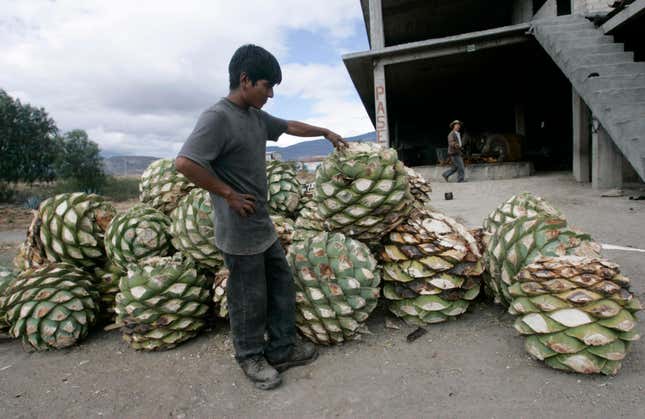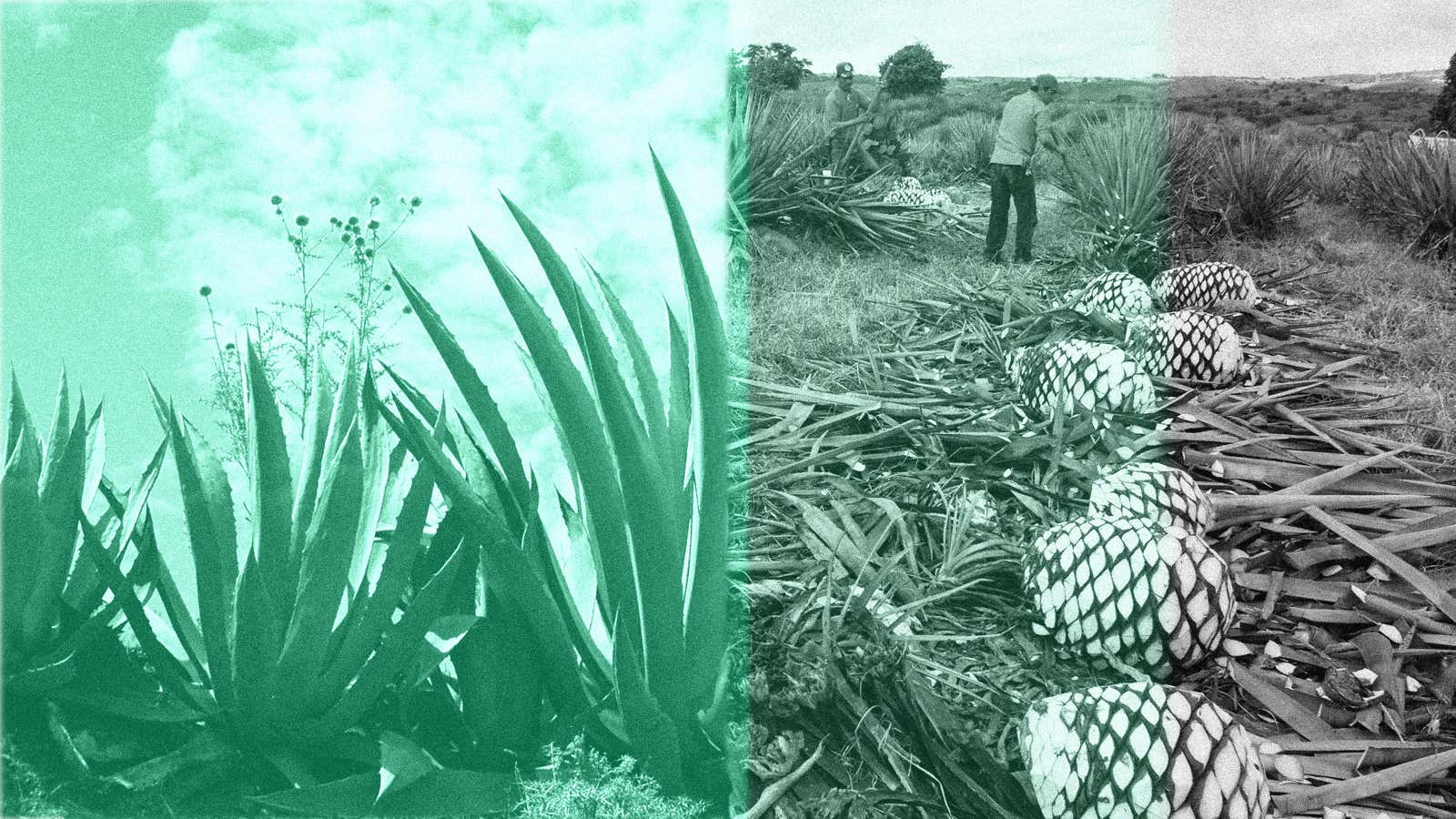Lee esta nota en español.
In the dusty, volcanic soil of Santa Catarina Minas, 25 miles south of the Mexican city of Oaxaca, the agaves can grow until they’re taller than Graciela Angeles. For nearly a century, Angeles’ family has been harvesting these agaves to make mezcal: cooking and crushing the hearts of the plants, then fermenting and distilling the liquor into a complex, fiery spirit. In the 1970s, they sold mezcal in small plastic jugs and recycled bottles. Mezcal was always a custom more than a product—something to be drunk to celebrate festivals and special occasions, or even as medicine, but not an international staple like its cousin tequila.
Then, just over a decade ago, the craze began. Bars and mixologists in the West promoted mezcal as an artisanal drink for hipsters, and mezcalerias popped up in big cities to serve mezcal flights. Someone invented the mezcal Negroni. The New Yorker devoted a long piece to mezcal. Celebrities like Bryan Cranston and LeBron James backed their own mezcal brands. Between 2013 and 2017, Mexico’s exports of mezcal nearly quadrupled, to 2.7 million liters a year; in 2019, that figure rose to 5.8 million liters. For Angeles’ family, who run Mezcal Real Minero, and for other traditional producers, the boom was an opportunity. The costs, though, have only become apparent over the last couple of years.
The dangers of over-harvesting wild agaves
In a bid to meet the skyrocketing demand for mezcal, producers in Oaxaca and elsewhere are over-harvesting wild agaves. Alfonso Valiente, an ecologist at the National Autonomous University of Mexico, remembers walking for three hours through a part of the state of Sonora, in Mexico’s northwest. “We found three plants. Just three.” Angeles tells of forests being chopped down to plant more agave, and of producers who have to buy agaves and have them trucked in from places 13 hours away. “And in the middle of the night, people steal agaves,” she said. “You could get 35,000 pesos ($1,725) for a ton of agave.” The disappearance of agaves from the wild threatens its landscape’s biodiversity. “Entire ecosystems could collapse,” Valiente said.
Mexico has been here before. When tequila achieved hard-liquor stardom, its source—the blue agave—was over-harvested from the wild as well. Big manufacturers resorted to growing the blue agave only in their own farms, cloning plants for ease and speed but rendering them virtually sterile in the process. To the Mexican government and alcohol companies, the rage for tequila is perhaps an unqualified success, but ecologists like Valiente bemoan it. For all intents and purposes, Valiente said, “the blue agave is almost extinct out there in wild.” It is a lesson in how the West’s consumerist fads often lead to the ransacking of a poorer country’s resources—and the pattern’s recurrence in mezcal shows the lesson hasn’t been learned. Valiente is part of a project to conserve agave biodiversity, using hindsight gleaned from tequila’s misadventures. “If we don’t do something, the same thing will happen with mezcal agaves.”
What happens if mezcal agaves go extinct?
Part of the reason for mezcal’s artisanal appeal is that, unlike tequila, it is made from different agaves in different parts of Mexico, which gives it variation and terroir. Angeles’ family uses 16 of Oaxaca’s 30-odd species; in total, Mexico has at least 53 species that can be used to make mezcal. These species are key to their ecosystems, Valiente said. The bats that sip nectar from agave flowers, for instance, then go on to cross-pollinate not only agave plants but also columnar cacti, the pipe-organ vegetation of the Mexican landscape. “And to give you an idea, one hectare of cacti may produce more than a ton of fruits, which maintain more than 100 animal species in the area,” Valiente said. If the agaves vanish, he warned, it’ll be like the first domino has been tipped over: The effects will cascade, and the ecosystem will collapse.

And the domino is already being nudged. Agaves are dwindling in two ways. The first, involving over-harvesting, threatens Mexican habitats not only by virtue of its own disappearance but also because producers are razing forests to plant more agave. “And since you need wood for the fires to make mezcal, you also see an over-exploitation of hard woods like oak,” said Jorge Larson, a biologist with Mexico’s National Commission for the Knowledge and Use of Biodiversity.
The second mode of disappearance involves how farmed agave are grown: by transplanting a section of the root, a form of cloning. This kind of monoculture, Angeles said, “is cheaper and quicker.” But cycle after cycle of cloning shrinks the agave’s genetic diversity, she said. “Each time, the plants degrade, so they’re more easily attacked by different plagues.”
The agaves won’t all go extinct next week, of course, Larson said. “Mexico is large and diverse, so the species are widely distributed and there are many populations of agave.” But the process has begun. Agaves take time to mature; some need as many as 30 years. Already, Larson said, there are parts of Mexico “where you don’t see the agaves, you only see a lot of little ones.” And under pressure from the mezcal industry and from investors, which want “high returns in rapid time,” he said, “producers are harvesting immature agaves.” These don’t have as much sugar to ferment, so more of these agaves are needed to produce a liter of mezcal. “There’s reason to be worried, there’s reason to start acting now.”
How to drink mezcal sustainably. As consumers, we play a role in the destruction of agave habitats—which means we can also take action to stop it. Learn what you can do in our primer.
What mezcal can learn from the tequila disaster
The history of tequila as a commercial drink is much older than that of mezcal, said Sarah Bowen, a sociologist at North Carolina State University and the author of “Divided Spirit: Tequila, Mezcal, and the Politics of Production.” The first regulations governing the production of tequila were laid down by the Mexican government in 1949, as part of a series of reforms dubbed “the Mexican miracle.” Ever since, Bowen said, “the standards have always been framed to favor industries, in a way that produces bigger and bigger quantities for global markets. They never preserved or even recognized traditional methods of small producers.”

When it came time to start thinking about mezcal standards—when the mezcal boom was on the horizon—the process started off in more collaborative fashion, but it didn’t pay much more attention to agave biodiversity than the mid-century tequila regulators. In 2009, when Bowen visited Oaxaca and Mexico City, “lots of people—small mezcal producers and their communities, some NGOs—were talking about needing a new way to govern and regulate mezcal.” She attended a meeting where people squabbled about the way ahead. “I didn’t feel optimistic about it, because the standards they were discussing had clearly been copied from the tequila regulations.” There wasn’t much discussion about how to grow agaves sustainably or about biodiversity, Bowen said. “Farmers, producers, companies—they were all left to figure this out on their own.”
Without rigorous guidance of how to tend to agave, Bowen said, the power dynamics between bottlers and retailers on the one hand and small producers and farmers on the other grew even more lopsided. As Londoners and New Yorkers ordered more and more mezcal cocktails in hipster bars, Mexican farmers and local producers, needing the income, felt compelled to harvest and manufacture higher and higher volumes of mezcal.
In 2018, when government regulations did finally come into force to specify what can and cannot be branded mezcal, they were still light on protecting agaves. One rule specifies that agaves must be ripe when harvested, but there is nothing more on how to cultivate agaves or preserve biodiversity. These rules are enforced by several non-profits and private bodies on behalf of the government. But these bodies, Valiente said, charge fees from the very mezcal producers they certify. “A lot of the ancestral and artisanal producers often cannot afford to pay these fees,” he said. It’s a double whammy. The small producers don’t receive sound advice on growing and harvesting agaves, Valiente said, and additionally, their mezcal goes uncertified. “These traditional guys are really at risk.”
The sustainability of agaves and the mezcal industry
Valiente’s preservation project, which started seven years ago and is backed by universities in five states, is a collaboration between researchers and farmers to grow pockets of wild agaves in their natural habitat. “In the state of Puebla, for example, we now have 8,000 plants in two separate areas.” The plants are genetically diverse and therefore more robust: “We don’t need any chemicals to protect them.” The farmers and biologists have together agreed, he said, that “70% of the plants will be for mezcal and 30% left in the field to feed the bats.”
Angeles, for her part, has formed a co-operative mezcal producers to build an agave seed bank. “Right now, we’ve collected seeds for eight species,” she said. Her family’s business had been using roots to transplant agaves, but in 2005, a biologist advised them about the virtues of seed cultivation. “Still, until 2018, we didn’t have the resources to make that switch to seeds, but now we’ve done that.”
Mezcal devotees are, for the most part, in the dark about how sustainable their drink is. Valiente’s university awards a “Bat Friendly” certification to mezcal producers who allow at least 5% of their agaves to flower for the benefit of bats, but the label is a work in progress. (Valiente himself is not part of the “Bat Friendly” labeling project.) Angeles is skeptical about the label. “Talking about the bat,” she said, “has become a trend in the US”—a gimmick for success. “But we need to think of the agave in a holistic context. We need to think of it as part of a whole… Then there’s a chance of avoiding an agave apocalypse.”
